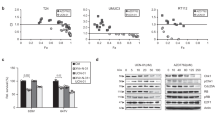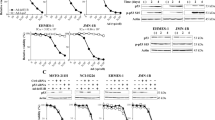Abstract
We have analyzed the ability of an adenoviral vector encoding the exon 1β region of the p14ARF tumor suppressor (ARF) to suppress the growth and viability of an array of tumor cell lines of various origins and varying p53 and Rb status, in order to establish the clinical potential of ARF. An important activity of ARF is regulation of p53 stability and function through binding to the mdm2 protein. By sequestering mdm2, ARF may promote growth suppression through the Rb pathway as well because mdm2 can bind to Rb and attenuate its function. Whereas the high frequency of ARF gene deletion in human cancers, accounting for some 40% of cancers overall, suggests that ARF would be a strong candidate for therapeutic application, the possible dependence of ARF activity on p53 and Rb function presents a potential limitation to its application, as these functions are often impaired in cancer. We show here that a replication-defective adenovirus, Ad1β, encoding the exon 1β region of ARF is most effective in tumor cells expressing endogenous wild-type p53. Nevertheless, Ad1β suppresses tumor cell growth and viability in vitro and in vivo, inducing G1 or G2 cell cycle arrest and cell death even in tumor cells lacking both functional Rb and p53 pathways, and independently of induction of the p53 downstream targets, p21, bax, and mdm2. These results point to an activity of ARF in human tumor cells that is independent of Rb or p53, and suggest that therapeutic applications based on ARF would have a broad clinical application in cancer.
This is a preview of subscription content, access via your institution
Access options
Subscribe to this journal
Receive 12 print issues and online access
$259.00 per year
only $21.58 per issue
Buy this article
- Purchase on Springer Link
- Instant access to full article PDF
Prices may be subject to local taxes which are calculated during checkout






Similar content being viewed by others
References
Zhang Y, Xiong Y, Yarbrough WG . ARF promotes MDM2 degradation and stabilizes p53: ARF-INK4a locus deletion impairs both the Rb and p53 tumor suppression pathways Cell 1998 92: 725–734
Pomerantz J, Schreiber-Agus N, Liegeois NJ et al. The Ink4a tumor suppressor gene product, p19Arf, interacts with MDM2 and neutralizes MDM2's inhibition of p53 Cell 1998 92: 713–723
Kamijo T, Weber JD, Zambetti G et al. Functional and physical interactions of the ARF tumor suppressor with p53 and Mdm2 Proc Natl Acad Sci USA 1998 95: 8292–8297
Kamijo T, Zindy F, Roussel MF et al. Tumor suppression at the mouse INK4a locus mediated by the alternative reading frame product p19ARF Cell 1997 91: 649–659
Honda R, Yasuda H . Association of p19(ARF) with Mdm2 inhibits ubiquitin ligase activity of Mdm2 for tumor suppressor p53 EMBO J 1999 18: 22–27
Rizos H, Darmanian AP, Mann GJ et al. Two arginine rich domains in the p14ARF tumour suppressor mediate nucleolar localization Oncogene 2000 19: 2978–2985
Xiao ZX, Chen J, Levine AJ et al. Interaction between the retinoblastoma protein and the oncoprotein MDM2 Nature 1995 375: 694–698
Carnero A, Hudson JD, Price CM et al. p16INK4A and p19ARF act in overlapping pathways in cellular immortalization Nat Cell Biol 2000 2: 148–155
Haber DA . Splicing into senescence: the curious case of p16 and p19ARF Cell 1997 91: 555–558
Vonlanthen S, Heighway J, Tschan MP et al. Expression of p16INK4a/p16alpha and p19ARF/p16beta is frequently altered in non-small cell lung cancer and correlates with p53 overexpression Oncogene 1998 17: 2779–2785
Kannan K, Munirajan AK, Krishnamurthy J et al. The p16INK4alpha/p19ARF gene mutations are infrequent and are mutually exclusive to p53 mutations in Indian oral squamous cell carcinomas Int J Oncol 2000 16: 585–590
Pinyol M, Hernandez L, Martinez A et al. INK4a/ARF locus alterations in human non-Hodgkin's lymphomas mainly occur in tumors with wild-type p53 gene Am J Pathol 2000 156: 1987–1996
Fulci G, Labuhn M, Maier D et al. p53 gene mutation and ink4a-arf deletion appear to be two mutually exclusive events in human glioblastoma Oncogene 2000 19: 3816–3822
Borgstrom P, Gold DP, Hillan KJ et al. Importance of VEGF for breast cancer angiogenesis in vivo: implications from intravital microscopy of combination treatments with an anti-VEGF neutralizing monoclonal antibody and doxorubicin Anticancer Res 1999 19: 4203–4214
Sacco MG, Gribaldo L, Barbieri O et al. Establishment and characterization of a new mammary adenocarcinoma cell line derived from MMTV neu transgenic mice Breast Cancer Res Treat 1998 47: 171–180
Torres Filho IP, Hartley-Asp B, Borgstrom P . Quantitative angiogenesis in a syngeneic tumor spheroid model Microvasc Res 1995 49: 212–226
Lehr HA, Leunig M, Menger MD et al. Dorsal skinfold chamber technique for intravital microscopy in nude mice Am J Pathol 1993 143: 1055–1062
Gjerset RA, Turla ST, Sobol RE et al. Use of wild-type p53 to achieve complete treatment sensitization of tumor cells expressing endogenous mutant p53 Mol Carcinog 1995 14: 275–285
Graham FL, Prevec L . Manipulations of adenovirus vectors In: Murray J, ed Methods in Molecular Biology New Jersey: Humana Press 1991
Zhang WW, Fang X, Branch CD et al. Generation and identification of recombinant adenovirus by liposome-mediated transfection and PCR analysis Biotechniques 1993 15: 868–872
Ghaneh P, Greenhalf W, Humphreys M et al. Adenovirus-mediated transfer of p53 and p16(INK4a) results in pancreatic cancer regression in vitro and in vivo Gene Ther 2001 8: 199–208
Lebedeva S, Bagdasarova S, Tyler T et al. Tumor suppression and therapy sensitization of localized and metastatic breast cancer by adenovirus p53 Hum Gene Ther 2001 12: 763–772
Stone S, Jiang P, Dayananth P et al. Complex structure and regulation of the P16 (MTS1) locus Cancer Res 1995 55: 2988–2994
Costanzi-Strauss E, Strauss BE, Naviaux RK et al. Restoration of growth arrest by p16INK4, p21WAF1, pRB, and p53 is dependent on the integrity of the endogenous cell-cycle control pathways in human glioblastoma cell lines Exp Cell Res 1998 238: 51–62
Parry D, Bates S, Mann DJ et al. Lack of cyclin D-Cdk complexes in Rb-negative cells correlates with high levels of p16INK4/MTS1 tumour suppressor gene product EMBO J 1995 14: 503–511
Zhao X, Day ML . RB activation and repression of C-MYC transcription precede apoptosis of human prostate epithelial cells Urology 2001 57: 860–865
Higashi H, Suzuki-Takahashi I, Yoshida E et al. Expression of p16INK4a suppresses the unbounded and anchorage-independent growth of a glioblastoma cell line that lacks p16INK4a Biochem Biophys Res Commun 1997 231: 743–750
Jarrard DF, Bova GS, Ewing CM et al. Deletional, mutational, and methylation analyses of CDKN2 (p16/MTS1) in primary and metastatic prostate cancer Genes Chromosomes Cancer 1997 19: 90–96
Schultz DC, Vanderveer L, Buetow KH et al. Characterization of chromosome 9 in human ovarian neoplasia identifies frequent genetic imbalance on 9q and rare alterations involving 9p, including CDKN2 Cancer Res 1995 55: 2150–2157
Steiner MS, Wang Y, Zhang Y et al. p16/MTS1/INK4A suppresses prostate cancer by both pRb dependent and independent pathways Oncogene 2000 19: 1297–1306
Gudas JM, Nguyen H, Klein RC et al. Differential expression of multiple MDM2 messenger RNAs and proteins in normal and tumorigenic breast epithelial cells Clin Cancer Res 1995 1: 71–80
Khan SH, Moritsugu J, Wahl GM . Differential requirement for p19ARF in the p53-dependent arrest induced by DNA damage, microtubule disruption, and ribonucleotide depletion Proc Natl Acad Sci USA 2000 97: 3266–3271
Stott FJ, Bates S, James MC et al. The alternative product from the human CDKN2A locus, p14(ARF), participates in a regulatory feedback loop with p53 and MDM2 EMBO J 1998 17: 5001–5014
Sanchez-Cespedes M, Reed AL, Buta M et al. Inactivation of the INK4A/ARF locus frequently coexists with TP53 mutations in non-small cell lung cancer Oncogene 1999 18: 5843–5849
Gazzeri S, Della Valle V, Chaussade L et al. The human p19ARF protein encoded by the beta transcript of the p16INK4a gene is frequently lost in small cell lung cancer Cancer Res 1998 58: 3926–3931
Weber JD, Jeffers JR, Rehg JE et al. p53-independent functions of the p19(ARF) tumor suppressor Genes Dev 2000 14: 2358–2365
Eymin B, Karayan L, Seite P et al. Human ARF binds E2F1 and inhibits its transcriptional activity Oncogene 2001 10: 1033–1041
Karayan L, Riou JF, Seite P et al. Human ARF protein interacts with Topoisomerase I and stimulates its activity Oncogene 2001 19: 836–848
Jackson MW, Lindstrom MS, Berberich SJ . MdmX binding to ARF affects Mdm2 protein stability and p53 transactivation J Biol Chem 2001 10: 10
Yang CT, You L, Yeh CC et al. Adenovirus-mediated p14(ARF) gene transfer in human mesothelioma cells J Natl Cancer Inst 2000 92: 636–641
Sweeney P, Pisters LL . Ad5CMVp53 gene therapy for locally advanced prostate cancer — where do we stand? World J Urol 2000 18: 121–124
Swisher SG, Roth JA, Nemunaitis J et al. Adenovirus-mediated p53 gene transfer in advanced non-small-cell lung cancer J Natl Cancer Inst 1999 91: 763–771
Swisher SG, Roth JA . Gene therapy in lung cancer Curr Oncol Rep 2000 2: 64–70
Nemunaitis J, Swisher SG, Timmons T et al. Adenovirus-mediated p53 gene transfer in sequence with cisplatin to tumors of patients with non-small-cell lung cancer J Clin Oncol 2000 18: 609–622
Logothetis CJ et al. AdCMV-p53 intraprostatic gene therapy preceding radical prostatectomy (RP): an in vivo model for targeted therapy development J Clin Oncol 1999 18: 1203A
Asai A, Miyagi Y, Sugiyama A et al. Negative effects of wild-type p53 and s-Myc on cellular growth and tumorigenicity of glioma cells. Implication of the tumor suppressor genes for gene therapy J Neuro Oncol 1994 19: 259–268
Cai Z, Capoulade C, Moyret-Lalle C et al. Resistance of MCF7 human breast carcinoma cells to TNF-induced cell death is associated with loss of p53 function Oncogene 1997 15: 2817–2826
Chen PL, Chen YM, Bookstein R et al. Genetic mechanisms of tumor suppression by the human p53 gene Science 1990 250: 1576–1580
Johnson P, Gray D, Mowat M et al. Expression of wild-type p53 is not compatible with continued growth of p53-negative tumor cells Mol Cell Biol 1991 11: 1–11
Lesoon-Wood LA, Kim WH, Kleinman HK et al. Systemic gene therapy with p53 reduces growth and metastases of a malignant human breast cancer in nude mice Hum Gene Ther 1995 6: 395–405
Takahashi T, Carbone D, Nau MM et al. Wild-type but not mutant p53 suppresses the growth of human lung cancer cells bearing multiple genetic lesions Cancer Res 1992 52: 2340–2343
Acknowledgements
This work was supported by Grants (RAG) from the California Cancer Research Program (no. 99-00517V-10140), the California Breast Cancer Research Program (no. 6JB-0077), the Department of Defense Breast Cancer Research Program (no. DAMD 17-96-1-6038), and the National Cancer Institute (no. CA69546).
Author information
Authors and Affiliations
Corresponding author
Rights and permissions
About this article
Cite this article
Saadatmandi, N., Tyler, T., Huang, Y. et al. Growth suppression by a p14ARF exon 1β adenovirus in human tumor cell lines of varying p53 and Rb status. Cancer Gene Ther 9, 830–839 (2002). https://doi.org/10.1038/sj.cgt.7700505
Received:
Published:
Issue Date:
DOI: https://doi.org/10.1038/sj.cgt.7700505
Keywords
This article is cited by
-
Mesenchymal stem cell-mediated delivery of therapeutic adenoviral vectors to prostate cancer
Stem Cell Research & Therapy (2019)
-
Siva1 inhibits p53 function by acting as an ARF E3 ubiquitin ligase
Nature Communications (2013)
-
ARF-induced downregulation of Mip130/LIN-9 protein levels mediates a positive feedback that leads to increased expression of p16Ink4a and p19Arf
Oncogene (2010)
-
Macrophage-mediated Bystander Effect Triggered by Tumor Cell Apoptosis
Molecular Therapy (2007)
-
Tumor suppressor ARF inhibits HER-2/neu-mediated oncogenic growth
Oncogene (2004)



